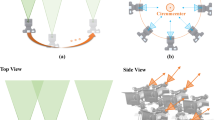Abstract
Correspondence establishment is a central problem of stereo vision. In a work Aloimonos and Herve (IEEE Trans Pattern Anal Mach Intell 12(5):504–510, 1990) presented an algorithm that could reconstruct a single planar surface without establishing point-to-point correspondences. The work uses images that are taken under a specific stereo configuration. In this paper, we generalize the algorithm to one for general stereo configuration of the cameras. We further provide an extension of the algorithm, so that not only distant or planar scene but also multi-surface polyhedral scene can be reconstructed. Experimental results on a number of real image sets are presented to illustrate the performance of the algorithm.
Similar content being viewed by others
References
Aloimonos J., Herve J.Y.: Correspondence-free stereo and motion: planar structure. IEEE Trans. Pattern Anal. Mach. Intell. 12(5), 504–510 (1990)
Baker, H.H., Binford, T.O.: Depth from edge and intensity-based stereo. In: Proceedings of 7th International Joint Conferences on Artificial Intelligence, pp. 631–636 (1981)
Barnett V., Lewis T.: Outliers in Statistical Data, pp. 328–340. Wiley, New York (1994)
Chung, R.: Correspondenceless stereo vision for planar or distant scene. In: Proceedings of the 2003 IEEE International Symposium on Computational Intelligence in Robotics and Automation, pp. 966–971, July 2003
Comanicu D., Meer P.: Mean shift: a robust approach toward feature space analysis. IEEE Trans. Pattern Anal. Mach. Intell. 24, 603–619 (2002)
Dhond U.R., Aggarwal J.K.: Structure from stereo- A review. IEEE Trans. Syst. Man Cybern. 19(6), 1489–1510 (1989)
Fusiello, A., Roberto, V., Trucco, E.: Efficient stereo with multiple windowing. In: Proceedings IEEE Conference on Computer Vision and Pattern Recognition, pp. 858–863 (1997)
Grimson W.E.L.: A computer implementation of a theory of human stereo vision. Philos. Trans. R. Soc. Lond. 292(1058), 217–253 (1981)
Harris, C., Stephens, M.: A combined corner and edge detector. In: Proceedings of the Fourth Alvey Vision Conference, pp. 147–151 (1988)
Heikkilä J.: Geometric camera calibration using circular control points. IEEE Trans. Pattern Anal. Mach. Intell. 22(10), 1066–1077 (2000)
Herman M., Kanade T.: Incremental reconstruction of 3D scenes from multiple, complex images. Artif. Intell. 30(3), 289–341 (1986)
Jones G.A.: Constraint, optimization, and hierarchy: reviewing stereoscopic correspondence of complex features. Comput. Vis. Image Underst. 65(1), 57–78 (1997)
Kanade T., Okutomi M.: A stereo matching algorithm with an adaptive window: theory and experiment. IEEE Trans. Pattern Anal. Mach. Intell. 16(9), 920–932 (1994)
Marr D., Poggio T.: Cooperative computation of stereo disparity. Science 194(4262), 283–287 (1976) 15 October (1976)
Marr D., Poggio T.: A computational theory of human stereo vision. Proc. R. Soc. Lond. B 204, 301–328 (1979)
Mori K., Kidode M., Asada H.: An iterative prediction and correction method for automatic stereo comparison. Comput. Graph. Image Process. 2, 393–401 (1973)
Okutomi M., Kanade T.: A multiple baseline stereo. IEEE Trans. Pattern Anal. Mach. Intell. 15(4), 353–363 (1993)
Okutomi M., Katayama Y., Oka S.: A simple stereo algorithm to recover precise object boundaries and smooth surfaces. Int. J. Comput. Vis. 47(1–3), 261–273 (2002)
Panton D.A.: A flexible approach to digital stereo mapping. Photogramm. Eng. Remote Sens. 44(12), 1499–1512 (1978)
Robert, L., Faugeras, O.: Curve-based stereo: figural continuity and curvature. In: Proceedings of IEEE Conference on Computer Vision and Pattern Recognition, pp. 57–62 (1991)
Scharf L.L.: The SVD and reduced-rank signal processing. In: Vaccaro, R.J. (eds) SVD and Signal Processing II: Algorithms, Analysis and Applications., pp. 3–31. Elsevier, Amsterdam (1991)
Scharstein D., Szeliski R.: Stereo matching with nonlinear diffusion. Int. J. Comput. Vis. 28(2), 155–174 (1998)
Scharstein D., Szeliski R.: A taxonomy and evaluation of dense two-frame stereo correspondence algorithms. Int. J. Comput. Vis. 47(1–3), 7–42 (2002)
Schmid C., Zisserman A.: The geometry and matching of lines and curves Over multiple views. Int. J. Comput. Vis. 40(3), 199–233 (2000)
Szeliski, R., Zabih, R.: An experimental comparison of stereo algorithms. In: IEEE Workshop on Vision Algorithms, September (1999)
Tao H., Sawhney H., Kumar R.: A global matching framework for stereo computation. In: Proceedings of the International Conference on Computer Vision 1, 532–539 (2001)
Torr, P.H.S.: http://research.microsoft.com/~philtorr/
Yuille A.L., Poggio T.: A Generalized Ordering Constraint for Stereo Correspondence. Artificial Intelligence Laboratory Memo, No. 777. Cambridge, MIT, Mass (1984)
Yuan, D., Chung, R.: Correspondence-free tereo vision for the case of arbitrarily-positioned cameras. In: Proceedings of the 2003 IEEE International Conference on Robotics and Automation, pp. 1688–1693 (2003)
Zhang, Z.Y.: http://www-sop.inria.fr/robotvis/personnel/zzhang/softwares.htm
Author information
Authors and Affiliations
Corresponding author
Rights and permissions
About this article
Cite this article
Yuan, D., Chung, R. Correspondence-free stereo vision: extension from planar scene case to polyhedral scene case. Machine Vision and Applications 21, 485–496 (2010). https://doi.org/10.1007/s00138-008-0177-4
Received:
Accepted:
Published:
Issue Date:
DOI: https://doi.org/10.1007/s00138-008-0177-4




